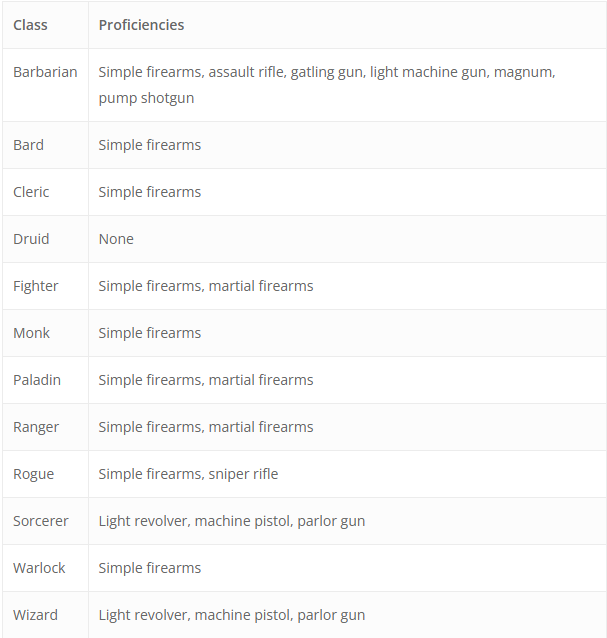Pravidla palných zbraní
Firearm Variant Rules
Black powder represents a paradigm shift in the art of warfare, fueling everything from powerful siege weapons to concealable, handheld guns. In many campaign settings, these firearms supplant the traditional scheme of weapons, forcing arrows, swords, and battleaxes into obsolesce. They might even be commonplace, a staple tool for hunting and home defense.
In other campaign settings, however, swords, firearms, and magic coexist equally. In these settings, since magic provides an alternative to their use, firearms are rarer and more imprecise, often requiring specialists like gunslingers to be truly effective. A setting of this type might seem very familiar, with some changes. A knight is just as likely to carry a handgun as a dagger, and infantrymen may shoulder rifles, rather than pikes, but adventurers still delve into dungeons for treasure, and castles still dot the landscape.
Damage Rolls with Firearms
Unlike other weapons, you don’t add your ability modifier to the damage roll of a firearm unless otherwise stated.
Two-Weapon Fighting with Firearms
Unlike other ranged weapons, you can engage in two-weapon fighting with two light firearms. When you do so, you subtract 2 from the damage roll of the bonus attack, to a minimum of 1 damage.
Firearm Proficiencies
Characters in most campaign worlds will not have proficiency with firearms, but in settings with widespread firearms, characters gain the following proficiencies:
Firearm Properties
All firearms produce a loud boom, audible out to half a mile. In addition, firearms require special ammunition and some of them have additional special properties.
Ammunition. You can use a weapon that has the ammunition property to make a ranged attack only if you have ammunition to fire from the weapon. Each time you attack with the weapon, you expend one piece of ammunition. The ammunition of a firearm is destroyed upon use.
Automatic. When you make an attack with this weapon on your turn, you can choose to make two attacks with disadvantage instead. These attacks always have disadvantage, regardless of circumstance. These attacks use double the normal amount of ammunition.
Concealable. You have advantage on Dexterity (Sleight of Hand) checks made to hide this weapon.
Foregrip. This weapon can be used with one or two hands. If used in two hands, its normal and long ranges double.
Mounted. This weapon is normally used while attached to a tripod, vehicle, or other bracing mount. You can mount or unmount this weapon as an action. While it is mounted, it can’t be moved. It can only be used to make an attack while unmounted if held by a Medium or larger creature with a Strength score of at least 15.
Recoil. After you make an attack with this weapon on your turn, every other attack you make with it until the end of your turn has disadvantage.
Reload. This weapon can be used to make a number of attacks before it must be reloaded. If you are not proficient with the weapon, reloading it takes an action. If you are proficient, you can reload it as a bonus action. Some weapons require longer to reload, even if you have proficiency, which is specified in the reload property. If reloading a weapon requires longer than one action, the weapon can’t be used to make attacks until reloading is finished.
Scatter. If you make an attack against a target that is within half this weapon’s normal range, you deal the damage value listed in parentheses instead of the weapon’s normal damage dice.
Sighted. This weapon has disadvantage on attack rolls made against targets within 20 feet.
Special Ammunition
All firearms require special ammunition. Most firearms use bullets, but some require even more specialized projectiles. For example, cannons use cannonballs and all scatter firearms use shells.
| Ammunition | Cost |
|---|---|
| Bullet | 2sp |
| Shell | 5sp |
Feats
A feat represents a talent or an area of expertise that gives a character special capabilities. It embodies training, experience, and abilities beyond what a class provides.
At certain levels, your class gives you the Ability Score Improvement feature. Using the optional feats rule, you can forgo taking that feature to take a feat of your choice instead. You can take each feat only once, unless the feat’s description says otherwise.
You must meet any prerequisite specified in a feat to take that feat. If you ever lose a feat’s prerequisite, you can’t use that feat until you regain the prerequisite.
Blitzwarrior
Prerequisite: Proficiency with simple firearms
When you roll damage for an attack you make with a firearm with the Scatter property, you can reroll one of the damage dice, and must use the new roll. Additionally, when take the Attack action using a sawed-off shotgun, you can take the Disengage action as a bonus action.
Run and Gun
Prerequisite: Proficiency with simple firearms
On any turn in which you use your action to Dash, you can make a ranged weapon attack as a bonus action.
Spray and Pray
Prerequisite: Proficiency with martial firearms
When it comes to bullets, quantity often beats quality. By holding down the trigger and firing nonstop, you gain the following benefits:
- As an action, while wielding a weapon that has the Automatic property, you can target a 10-foot cube area with a hail of bullets. Each creature in the area must succeed on a Dexterity saving throw (DC equals 8 + your proficiency bonus + your Dexterity modifier) or take the weapon’s normal damage. This action expends ten pieces of ammunition.
- You can use your Strength modifier instead of your Dexterity modifier when making attack rolls with a weapon that has the Mounted property.


